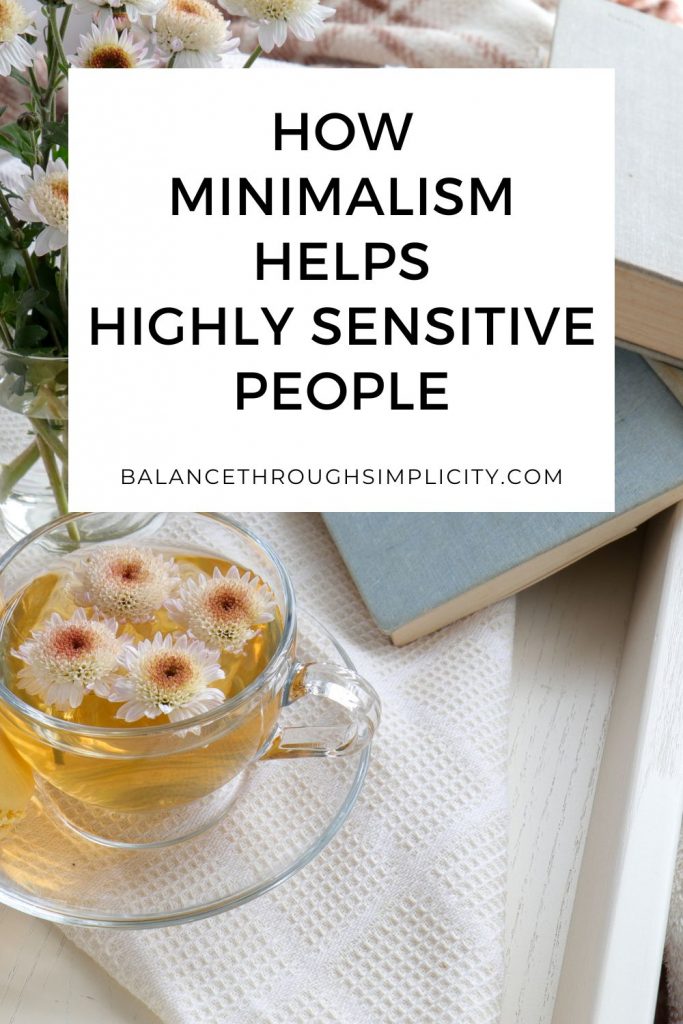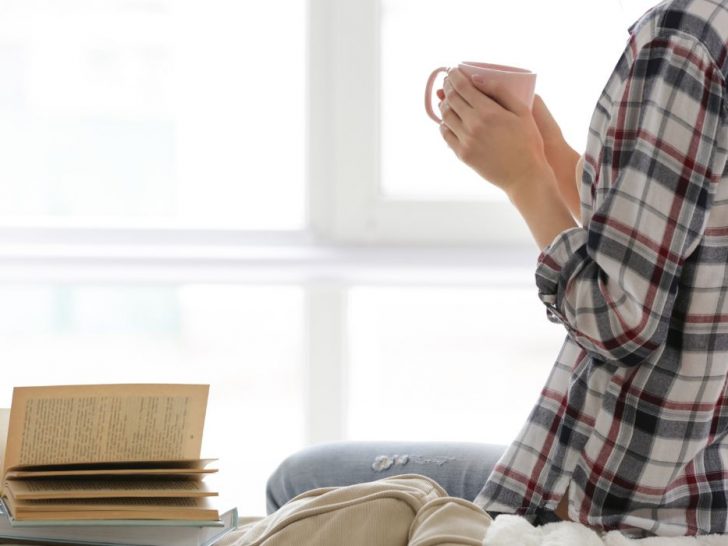HOW MINIMALISM CAN HELP HIGHLY SENSITIVE PEOPLE
Are you a Highly Sensitive Person feeling overwhelmed by busy life and the outside world? In this article I’m sharing some gentle tips on how minimalism can help Highly Sensitive People find more peace, calm and space at home and in life.
A PERSONAL PERSPECTIVE
When I was younger, I was often described as shy and oversensitive. I didn’t like busy or noisy places and struggled when building friendships as a child and teenager. I would easily pick up on subtle tones of voice, body language and I’d try to interpret what people were thinking about things (or about me!). I would need quiet, alone time to reconnect with myself and process everything I’d experienced.
Maybe these were the first signs that I was highly sensitive, even if I didn’t know it was ‘a thing’ until many, many years later. Maybe also, this is why I’m naturally drawn to find a quieter, calmer life as much as I can – kids, work, and general life challenges aside!
WHAT IS A HIGHLY SENSITIVE PERSON?
Highly Sensitive Person is the description given to people who have a high sensitivity to their internal and external surroundings. Dr Elaine Aron began researching high sensitivity in 1991 and after years of study and research, her work is a leading authority and resource on what it means to be a Highly Sensitive Person. Dr Aron’s book, The Highly Sensitive Person, is a wonderful and insightful read (with a self-test to help you decide if you’re an HSP) and her website (hsperson.com) is a useful resource for anyone thinking they’re too sensitive for our busy, noisy and complex world! So, if you’d like to read more about HSPs, these are great resources to take a look at.
CHARACTERISTICS OF HSPs
A Highly Sensitive Person (HSP) is easily overwhelmed by external stimuli such as bright lights, too much noise and movement. We don’t like violent movies. We struggle with feeling overwhelmed and overloaded very easily because we’re often highly observant, perceptive and intuitive of other people’s needs and feelings so we might prefer calm, quiet, peace and sometimes solitude to help restore balance to body and mind.
We’re also deeply in tune with our own needs and aim for a life without confrontation or stress. As I mentioned earlier, I was often labelled as shy or oversensitive when I was growing up and, until I understood why I reacted to certain situations like I do, I thought I was too!
High sensitivity is different to introversion. Dr Aron estimates that about 70 percent of HSPs are also introverts so no wonder that many people confuse HSP for introversion, although that’s not necessarily the case as 30% of HSPs are extroverts. The difference between the two is where the person gets their energy from.
Introverts feel refuelled by having solitude and quiet, extroverts get their energy from interacting and being with other people. An HSP introvert will be highly in tune with the people around them but still find being in their company draining! As an HSP extrovert, you might need regular and sustained contact with others because of your extroversion but find the over-stimulation that comes with it, too much for your HSP traits!
Being an HSP is not a negative and is not too uncommon. As Dr Aron writes on her website, “It is found in 15 to 20% of the population – too many to be a disorder, but not enough to be well understood by the majority of those around you.” So, if you feel easily overwhelmed by and too sensitive for the world around you, it may be that you’re an HSP!
WHAT IS MINIMALISM?
Minimalism is a lifestyle encouraging us to focus more on the things that matter and less on the things that don’t. To prioritise a life full of meaning and experiences rather than mindless drifting, clutter, busyness and consumption. Minimalism is a wonderful way of ensuring that your decisions and days help you live your life true to yourself, your heart and your potential.
To use the words of Joshua Becker and my favourite definition of minimalism…
“Minimalism is the intentional promotion of the things we most value and the removal of anything that distracts us from it.”
But, of course, if you prefer, you could use the term simplifying or decluttering your life, if that feels more right for you.

HOW MINIMALISM HELPS HIGHLY SENSITIVE PEOPLE
Here are some ways I’ve found simplifying my life helps me balance my needs with those of the outside world and how minimalism helps highly sensitive people.
1. Saying no and being less busy
We can declutter our schedules like we declutter our homes. Take a look at your schedule for the next day, week or month and see what fills your time. Some things we have to do and some we do because we want to, but there are maybe some other activities on your calendar that have crept on there out of habit, for fear of missing out (FOMO) or because you just didn’t know how to say no.
Could you rethink your calendar and your needs and find some free time by cancelling or postponing an activity? Being less busy and having a more minimalist schedule gives you more breathing space in your calendar. You could fill this with something that suits your needs more – rest, relaxation, less rushing, overcommitting and chasing your tail. Highly Sensitive People feel easily overwhelmed so giving yourself time could be a helpful and precious gift for a less stressful day.
Action point: Try these tips on how to be less busy or read these signs that you might be too busy already. Do any of them resonate with you?
2. Less on your To Do list and less multi-tasking
HSPs don’t like the pressure and stress that comes with having lots of things to do and weighing on their mind. Multi-tasking feels difficult and raises our anxiety levels. Adopt a minimalist approach and create a simple but strategic To Do list. Be clear on your absolute priority for the day and list no more than 3 things that you need to get done. Use another list to brain dump everything you need or would like to do but keep your actual To Do list short and sweet. You’re much more likely to achieve three things than a list of 20. Less on your To Do list means less multi-tasking and more focus and sense of achievement on the things you do get done.
Action point: Read this article on how to write a great To Do list and build your own list for tomorrow.
3. More time to rest
With less on your schedule and your To Do list then you’ll hopefully find more time to rest, in whatever way that means to you. Rest is a vital part of a healthy self-care routine but we so often see it as a luxury that we can’t afford. Unfortunately, time to rest seldom happens because we want or need it, it usually only happens because we MAKE it happen! So, with an emptier schedule and more strategic To Do list, why not factor in plenty of time to rest and make a date with yourself to do this regularly?
Action point: Knock something off your schedule. Postpone or cancel it in a way that feels comfortable to you. Plan what you’ll do with that time instead (even if it’s to do nothing!).

4. Place to rest and withdraw
As an HSP, the world can seem an overstimulating and exhausting place so it’s important that our homes provide relief. As Peter Walsh said “Your home should be the antidote to stress, not the cause.”
A minimalist home has less clutter and usually more space. The rooms are often laid out for the purpose they’re intended and everything has a ‘home’ for when not in use. So, there’s often more scope for creating a space in your home where you can rest and withdraw. It might be a quiet corner of your living room, a spare bedroom turned into a den or meditation and journaling space or even your bedroom where you can retreat away from the hustle and bustle of family life in the rest of the home. What do you need to create a quiet place for yourself at home to rest and withdraw?
Action point: Declutter your bedroom and create a calming space for retreat, relaxation and rest.
5. Adjust your surroundings to meet your needs
My external surroundings play a large role in how my inner environment (my body and mind) feels too. I dislike bright lights, noisy spaces and too much movement. Maybe it’s for this reason that I choose quiet, muted colours and simple patterns and textures. Whilst there are many minimalists who love colour and bold expression, I think it’s probably fair to say that minimalists generally tend to opt for quieter décor style choices too. Simple over complicated, in design aesthetic as well as lifestyle choice.
That being said, I also love art so I do have some key pieces of colourful art (mostly painted or drawn by my creative elder daughter!) hanging with love and pride on my walls. For Highly Sensitive People affected by their surroundings, it’s not always the case that we don’t want anything in our surroundings but perhaps we’re just really choosy about what we allow in those surroundings. Minimalism helps us to do that because what we love and want to stand out isn’t lost amidst the clutter of too much stuff!
Action point: Close your eyes and visualise a room in your home as you’d really like it to look. Make a mood board for your room or gather some ideas from Pinterest. Does the room now reflect how you’d like it to look? How does it make you feel? Calm and relaxed or overstimulating and busy? What can you do to change the vibe?
6. Less visual stimulation
Building on the point above, too much visual stimulation can be overwhelming for HSPs. This could be colours, patterns, stuff, lighting, scents, but also clutter on countertops, shelves, desks – anywhere that your eye is drawn to and your mind has to process. Clutter has been found to raise stress levels for people who aren’t HSPs so it’s no wonder that HSPs feel even more stressed by cluttered homes and too much in their line of sight. Reduce your clutter to reduce the visual stimulation and feel your stress response drop.
Action point: Clear your flat surfaces, table-tops and counters. What else is making your home look cluttered?
7. Plan and prepare to avoid upsetting or overwhelming situations
My home is my sanctuary and it’s where I come back to at the end of the day and launch myself from at the start of the next. Although life certainly presents regular challenges, my home is a safe resting place where I can prepare myself to face the world! Minimalism won’t make your life easy but a calm home that’s easy to keep clean and tidy, more time for things you want to do and more space for creating a life that feels right to you, will all help Highly Sensitive People plan, prepare and reduce life’s inevitable ups and downs.
Action point: What upsets or overwhelms you? Does this situation happen often? Why EXACTLY does it stress you out? What steps could you take to lessen or mitigate it? What strategies do you have in place when you do feel upset or overwhelmed?

8. More space for hobbies and leisure activities
I created this blog because I wanted to share my experiences of decluttering my home and simplifying my life so that it might help others who’d like to try it for themselves. I don’t believe that a minimalist life is right for everyone, we have to be ready and receptive to embrace change and try something new, but I feel there are some wonderful benefits if you find the right version of minimalism for you.
However, the other reason I spend hours each week writing content and sharing my thoughts is because this website is also my calm and creative space and I look forward to spending time tapping away on the keyboard and sharing my message with anyone who might like to read it! Thank you for reading by the way!
Hobbies and leisure interests help us grow, learn, have fun and switch off from the daily grind and the hobbies we choose reflect our needs, interests and skills. As an HSP, I choose hobbies which are quiet, relaxing and use my love of learning, teaching, writing and creating. However, many of us need space for our hobbies – physical, emotional and time space, and that’s what minimalism helps us have.
Action point: Consider your current hobbies and interests. What space, time and equipment do you need for them? Do you have these resources available to you? No hobbies or interests? What about time for self-care and taking 10 minutes out for yourself each day to explore things you might like to do?
9. Prioritise what matters most
Circling back to the definition of minimalism from Joshua Becker that I quoted before, minimalism is about prioritising what’s important to YOU, not what’s important to your To Do list or anyone else’s agenda. Yes, we all have responsibilities and things we have to do, but what about creating space, time and freedom for other important things – family, friends, peace, experiences, memories, happiness and contentment? There may be trade-offs, we can’t do this or try that without saying no or giving something else a miss but this is a choice that might be worth making.
A minimalist life allows us flexibility and wiggle room to carve out more joy, ease and freedom in our life for what we want and need. It’s not a magic wand for a perfect life but it may encourage you to work out what a meaningful and fulfilling life looks like to you. And, as an HSP who needs to be in tune with themselves and their emotions, I think minimalism for Highly Sensitive People helps us prioritise what matters most.
Action point: Not sure what matters most to you? Try this article on how to define your priorities and get a free worksheet to help you.
10. Helps us live true to ourselves
For anyone who feels out of sync or at odds with the demands of busy life, as an HSP or for any other reason, it’s hard to find harmony between what we need and want and what life requires of us. All of the ways minimalism helps Highly Sensitive People that I’ve mentioned in this article may help us to live true to ourselves. Understanding that you might need extra peace, calm, silence, solitude and finding ways to give yourself that at home, in your schedule and in your life, are key to helping HSPs be authentic, kind to themselves and ultimately, bring out their best!
Action point: Journal your thoughts around this question – “What do I need to help me live true to myself and my needs?”

SHARE YOUR THOUGHTS
I hope you enjoyed this article on how minimalism helps Highly Sensitive People. When I first read about high sensitivity it was such an eye-opener for me, helping to explain why I felt and reacted to things like I do. Minimalism has been a tool to help me balance my needs as a Highly Sensitive Person with those of my busy life. In the past, they’ve felt at odds with each other but minimalism helps me find balance in life and in my body and mind!
Are you a HSP? Are you a minimalist? Do you have experience of the two working together and, if so, what has been the greatest benefit? I’d love to hear from you if you’d like to leave a comment below!
OTHER RESOURCES FOR HIGHLY SENSITIVE PEOPLE
Dr Elaine Aron has published several other valuable resources for HSPs.
Her book, The Highly Sensitive Parent: Be Brilliant In Your Role, Even When the World Overwhelms You, is a guide and source of support for HSP parents wanting themselves and their children to thrive during their parenting journey.
Another of Dr Aron’s books, The Highly Sensitive Child, is for those interested in helping children thrive when the world overwhelms them.
You can read more about these resources, plus many others on Dr Aron’s website, hsperson.com.
MORE RESOURCES ON MINIMALISM FOR HIGHLY SENSITIVE PEOPLE
Here are some more articles which might be helpful if you’re interested in minimalism as a Highly Sensitive Person:


Laura
Thursday 22nd of June 2023
As an HSP introvert, I completely agree with everything you've written! Thanks for another great article, Antonia.
Balance Through Simplicity
Friday 23rd of June 2023
Hi Laura, thank you for your lovely comment!